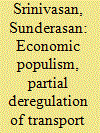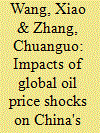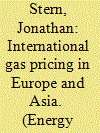|
|
|
Sort Order |
|
|
|
Items / Page
|
|
|
|
|
|
|
| Srl | Item |
| 1 |
ID:
143473


|
|
|
|
|
| Publication |
New Delhi, ICRIER, 2001.
|
| Description |
23p.pbk
|
| Series |
Working Paper; no. 63
|
|
|
|
|
|
|
|
|
|
|
|
Copies: C:1/I:0,R:0,Q:0
Circulation
| Accession# | Call# | Current Location | Status | Policy | Location |
| 044902 | 330/BAR 044902 | Main | On Shelf | General | |
|
|
|
|
| 2 |
ID:
133227


|
|
|
|
|
| Publication |
2014.
|
| Summary/Abstract |
The Indian political class is known to employ populist, albeit economically unsustainable, measures to replace intrinsic 'valence', especially shortly prior to election windows. Such measures include loan-waivers, interest rate concessions, provision of free electricity for agriculturists, etc. The union government's leverage to maneuver and to micro-manage retail fuel prices within partially deregulated environments is hypothesized to provide incumbents with an advantage over rival contestants in the electoral process. This paper analyzes the evolution in the retail prices of diesel and petrol (gasoline), and the transfer of such evolution, into the inflation index of the 'all commodity' basket. It is observed that when international benchmark prices are relatively low and domestic inflation is moderate, the transfer occurs within about 42 weeks. During periods of high oil prices-frequently above USD 100 a barrel-and high inflation-higher than 5.00-5.50%-prices of petroleum distillates tend to feed into overall inflation more rapidly, within about 34-40 weeks.
The study, covering a total of 82 elections for the central and state (provincial) governments during the period 2000 to 2013, concludes that even as patterns of manipulation of prices are apparent, ceteris paribus, such leverage does not necessarily seem to translate into favorable electoral outcomes. This conclusion reiterates observations that economic im/prudence may not necessarily determine electoral outcomes, and that the basis for electoral choices made by the Indian voter-consumer remains subjective.
|
|
|
|
|
|
|
|
|
|
|
|
|
|
|
|
| 3 |
ID:
166951


|
|
|
|
|
| Summary/Abstract |
The current study examines the effect of a set of Electricity Act, adopted by India in 2003, on the price gap between two specific consumer groups-industrial and commercial. Paying a higher tariff than the other consumer groups, these two groups have been referred to as the ‘subsidizing’ groups of consumers in the Indian context. While the effect of reforms between the ‘subsidizing; ’ and subsidized’ groups has received attention, research on the effect of reforms on the tariff gap within the ‘subsidizing’ sector has been under-addressed. Using data on all major states of the country spanning from 2004-2014, the study uses a graphical exposition, excerpts of policy document and panel econometric modelling technique. The study focuses on six aspects of the policy and emphasizes on adoption and implementation extent and finds that mere policy adoption has no strong effect on tariff gap. Instead, effective implementation may be beneficial in narrowing the tariff gap within the subsidizing sectors as well. Specifically, unbundling of the electricity sector into three different segments and establishment of an independent regulatory authority in the state may lead to narrowing tariff gap if implemented effectively.
|
|
|
|
|
|
|
|
|
|
|
|
|
|
|
|
| 4 |
ID:
133189


|
|
|
|
|
| Publication |
2014.
|
| Summary/Abstract |
Wind power represents a significant percentage of the European generation mix and this will increase to fulfill the renewable energy targets. Different balancing rules are applied to wind power among the countries; for instance, to what extent wind power producers (WPPs) are responsible for the energy imbalances and how those imbalances are penalized. This paper discusses those different rules and evaluates their effects on WPP bidding strategies. To do so, a quantitative analysis is presented for an offshore wind farm, considering the differences in the balancing rules and prices of Belgium, Denmark, Germany and the Netherlands. The quantitative approach consists of a stochastic optimization model that maximizes the profits of a WPP by trading in different markets (day-ahead and intraday) and computes the final energy delivered. The model considers uncertainties of most important parameters such as wind energy forecasts and prices at different time frames. The results show that the imbalance pricing design and the allocation of balance responsibility significantly affect WPP' revenues. Additionally, WPPs deviate differently from the expected energy depending on the balancing rules, which can impact the system. Furthermore, these balancing rules should be considered with other market regulations, such as the design of support schemes.
|
|
|
|
|
|
|
|
|
|
|
|
|
|
|
|
| 5 |
ID:
133210


|
|
|
|
|
| Publication |
2014.
|
| Summary/Abstract |
This paper investigated the impacts of oil price shocks on China×s fundamental industries. In order to analyze the reactions of different industries to oil price shocks, we focused on four fundamental industries: grains, metals, petrochemicals and oil fats. We separated the oil price shocks into two parts, positive and negative parts, to investigate how commodity markets react when oil prices go up and down. We further studied the extreme price movements, called jumps, existing in the oil markets and how jump behavior has affected China×s commodity markets. Our results suggest that asymmetric effects of oil price shocks did exist in the four markets and the negative oil price shocks had stronger influences on the four markets in China. The petrochemicals market suffered most from the oil price shocks, and the grains market was least sensitive to the shocks. When jumps occurred in the crude oil market, the four commodity markets would be affected differently. The oil fats market and petrochemicals market tended to "overreact" to jumps.
|
|
|
|
|
|
|
|
|
|
|
|
|
|
|
|
| 6 |
ID:
043266


|
|
|
|
|
| Publication |
London, Routledge & Kegan Paul, 1972.
|
| Description |
xiii,276p.
|
| Standard Number |
0710073062
|
|
|
|
|
|
|
|
|
|
|
|
Copies: C:1/I:0,R:0,Q:0
Circulation
| Accession# | Call# | Current Location | Status | Policy | Location |
| 010947 | 339.5/BAL 010947 | Main | On Shelf | General | |
|
|
|
|
| 7 |
ID:
126805


|
|
|
|
|
| Publication |
2014.
|
| Summary/Abstract |
In Continental Europe and LNG importing Asia, international gas prices reflect the market fundamentals of the 1970s-1990s when gas was replacing oil products and crude oil in energy balances. By the end of the 2000s, fundamentals in both these regions had changed significantly, but gas price formation mechanisms had not. This created major problems for buyers locked into long term contracts indexed to crude oil and oil product prices, which had risen to levels far above gas market fundamentals. By 2013, the transition to hub-based pricing was well advanced in Europe and dominant in the large markets in the north west of the Continent. In Asia the "crisis of fundamentals" was only just starting to be addressed with a transition to market pricing an urgent imperative, but still a distant prospect.
|
|
|
|
|
|
|
|
|
|
|
|
|
|
|
|
| 8 |
ID:
032238


|
|
|
|
|
| Publication |
New York, Praeger Publishers, 1972.
|
| Description |
x, 126p
|
| Series |
Praeger special studies in international economics and development
|
|
|
|
|
|
|
|
|
|
|
|
Copies: C:1/I:0,R:0,Q:0
Circulation
| Accession# | Call# | Current Location | Status | Policy | Location |
| 011304 | 338.52/ARP 011304 | Main | On Shelf | General | |
|
|
|
|
| 9 |
ID:
163192


|
|
|
|
|
| Summary/Abstract |
In the early morning of July 31, 2015, masked attackers threw firebombs into two Palestinian homes in the West Bank village of Duma, south of Nablus, killing three Palestinian civilians. Contrary to claims by Israeli and Palestinian politicians, this attack was neither an isolated anomaly nor just another incident of settler violence. Instead, it was the latest attack in an important but largely unknown phenomenon called “price-tag,” in which a loosely connected group of young Israelis called “hilltop youth” burn Palestinian mosques and destroy property in hundreds of attacks accompanied by threatening graffiti that references Israeli settlers, outposts, and anti-Arab slogans. Using an original dataset of price-tag incidents and interviews with key actors, we demonstrate that the perpetrators, targets, and strategies of price-tag are different than previous patterns of settler violence. Whereas previous settlers saw the Israeli state as legitimate and largely decided to cooperate with it, the hilltop youth have decided to confront it by using price-tag attacks to deter settlement withdrawals and chain-gang the state into a conflict with the Palestinians. This analysis of the strategic logic of price-tag reveals its potential to shift the political landscape within and between Israelis and Palestinians.
|
|
|
|
|
|
|
|
|
|
|
|
|
|
|
|
| 10 |
ID:
150729


|
|
|
|
|
| Summary/Abstract |
The German market has seen a plunge in wholesale electricity prices from 2007 until 2014, with base futures prices dropping by more than 40%. This is frequently attributed to the unexpected high increase in renewable power generation. Using a parsimonious fundamental model, we determine the respective impact of supply and demand shocks on electricity futures prices. The used methodology is based on a piecewise linear approximation of the supply stack and time-varying price-inelastic demand. This parsimonious model is able to replicate electricity futures prices and discover non-linear dependencies in futures price formation. We show that emission prices have a higher impact on power prices than renewable penetration. Changes in renewables, demand and installed capacities turn out to be similarly important for explaining the decrease in operation margins of conventional power plants. We thus argue for the establishment of an independent authority to stabilize emission prices.
|
|
|
|
|
|
|
|
|
|
|
|
|
|
|
|
| 11 |
ID:
044946


|
|
|
|
|
| Publication |
London, Faber and Faber, 1972.
|
| Description |
vii,210p.
|
| Standard Number |
0571094252
|
|
|
|
|
|
|
|
|
|
|
|
Copies: C:1/I:0,R:0,Q:0
Circulation
| Accession# | Call# | Current Location | Status | Policy | Location |
| 010987 | 338.52/COL 010987 | Main | On Shelf | General | |
|
|
|
|
| 12 |
ID:
162241


|
|
|
|
|
| Summary/Abstract |
This paper explains and assesses the UK experience with determining prices and profitability for non-competitive defence contracts. Three periods are considered, namely pre-1968, the 1968 Profit Formula Agreement and the changes introduced in 2014. Two cases of ‘excessive’ profits were major determinants of the 1968 Profit Formula Agreement; but continued dissatisfaction with the 1968 Agreement led to changes in 2014. The historical overview of UK experience provides a basis for understanding current UK policy and offers insights for other countries facing similar policy challenges. A critique is presented of UK policy on single source pricing and profitability.
|
|
|
|
|
|
|
|
|
|
|
|
|
|
|
|
| 13 |
ID:
124630


|
|
|
|
|
| Publication |
2013.
|
| Summary/Abstract |
The Chinese households that make up approximately a quarter of world households are facing a residential power tariff reform in which a rising block tariff structure will be implemented, and this tariff mechanism is widely used around the world. The basic principle of the structure is to assign a higher price for higher income consumers with low price elasticity of power demand. To capture the non-linear effects of price and income on elasticities, we set up a translog demand model. The empirical findings indicate that the higher income consumers are less sensitive than those with lower income to price changes. We further put forward three proposals of Chinese residential electricity tariffs. Compared to a flat tariff, the reasonable block tariff structure generates more efficient allocation of cross-subsidies, better incentives for raising the efficiency of electricity usage and reducing emissions from power generation, which also supports the living standards of low income households.
|
|
|
|
|
|
|
|
|
|
|
|
|
|
|
|
| 14 |
ID:
166947


|
|
|
|
|
| Summary/Abstract |
Traditionally, there has been a premium in green pricing plans for electricity supply with high renewable energy content. Using a sample of 710 plans offered in December 2018 by Texas's competitive retailers to residents in Dallas, Houston, Corpus Christi and Abilene, we document that there is no longer a statistically significant renewable energy premium in Texas's retail electricity pricing. Attributable to the declining cost of renewable energy, this finding's policy implication is that continuing development of renewable energy is unlikely to adversely impact Texas's residents.
|
|
|
|
|
|
|
|
|
|
|
|
|
|
|
|
| 15 |
ID:
094890


|
|
|
|
|
| Publication |
2010.
|
| Summary/Abstract |
The price structure of district heating has been no major scientific issue for the last decades in energy-related research. However, today trends in district heating pricing tend to move towards a more customer-oriented approach with predetermined prices under a longer periods, leading to a more complex price structure. If a district heating supplier offers district heating with predetermined prices in order to compete with similar electricity offers, the financial risk of the new price structure is significantly higher than the risk of an ordinary variable cost offer based on short-run marginal cost. In contrary to an electricity seller, the district heating company cannot transfer all of the risk of predetermined prices to the financial market, instead the company is thrown upon its own ability to handle the risk by, e.g., hedging its own energy purchase. However, all uncertainties cannot be coped with in this manner. Thus, there is a need for a methodology that can be used to estimate the financial risk of different price structures and to value different opportunities to reduce the risk. In this article, we propose a methodology, implemented in prototype software, to evaluate the risk associated with new price structures in district heating.
|
|
|
|
|
|
|
|
|
|
|
|
|
|
|
|
|
|
|
|
|